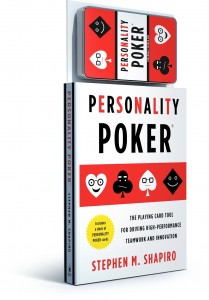 There’s a new wave of poker madness about to start. I’m not talking Texas Hold-em. I’m talking about Stephen M. Shapiro’s new book, Personality Poker, the playing card tool for driving high performance teamwork and innovation. Personality Poker is being released on Thursday, October 28th, 2010.
There’s a new wave of poker madness about to start. I’m not talking Texas Hold-em. I’m talking about Stephen M. Shapiro’s new book, Personality Poker, the playing card tool for driving high performance teamwork and innovation. Personality Poker is being released on Thursday, October 28th, 2010.
This book is innovative in several ways. First, it’s a truly novel way to assess yourself, teams, and companies. The built in assessment reveals your personality preferences, but perhaps more importantly, it’s been designed to tell how your traits fit into the innovation process. Second, it’s not just a book, it’s also a deck of cards, a card game, which comes packaged with the book. I’ve never seen this kind of packaging done before and it’s a testament to Stephen’s persuasion skills that he got Penguin to do it. Next, it’s a process, and a very powerful one, that can be used to usefully improve innovation teams and organizations. Finally, it may be the most accessible personality assessment ever devised — because it’s a game, it’s inherently fun. Because it’s been well researched and tested, it’s deeply meaningful.
There are many useful assessments out there, and some are routinely used as a part of an innovation program. The MBTI, MMPI, KAI, and the FourSight instrument are the ones I’m most familiar with, and there are others. What’s different about Shapiro’s new tool is that it’s designed to work with the innovation process directly. Team building experts and innovation consultants have had to create their own exercises and methods to integrate the older assessments into their programs. If they use Shapiro’s new assessment, they’ll find that a lot of thinking has already been done for them. This “game” integrates well with innovation programs — it plays well with others.
The real power of the book, and integrated game, is not simply reading it — it’s using it. Shapiro has made that remarkably easy to do. The nature of the game is interactive to begin with. In playing it with others in this instance you learn about yourself, you learn about your peers, and you learn ways to work together better. Shapiro lays out for readers how to use the game in a full fledged, full process innovation program. According to the book, this assessment has already been used by over 25,000 people — that’s excellent validation as to its precision and effectiveness.
Beyond the core content of the assessment/game, I have to say I love Shapiro’s writing style. It’s direct, it’s entertaining, anecdotal, and full of the voice of real world experience. The story of how he invented the game itself is a classic innovation story. I’ll only say it happened in Vegas! Clearly, he’s been doing corporate innovation work for many years, and the book, the game, and now his readers all benefit. Many business books are easy to put down in spite of great content. This is different. It’s compelling “how to” and it invites you to jump in and play.
I predict this book will sell widely, and will become a bit of a corporate standard for innovation team building. Buy it and try it with your team, I guarantee it will provide you a greater awareness of who you are — and that’s where innovation starts. Start dealing!


